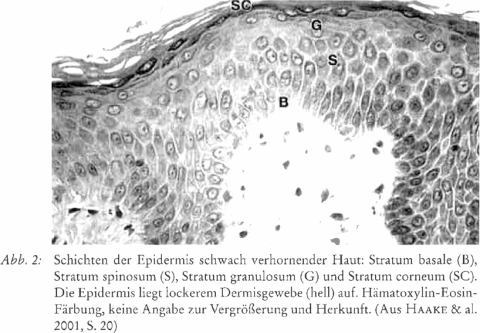Die Dreigliederung der Haut
Jahrbuch für Goetheanismus 2005, 2005,
P.80-134 |
DOI: 10.18756/jfg.2005.80
Biologie | Language: German | €6
ARTIKELREFERENZ EXPORTIEREN
- Downloadkosten : €6
Zusammenfassung:
Referenzen
- BENNINGHOFF, A. & DRENCKHAHN, D. (2004): Anatomie Bd. 2. München
- BRAUN-FALCO, O., PLEWIG, G. & WOLFF, H. II. (1996): Dermatologie und Venetologie, S. 914. Berlin
- CHRISTEN, Ph. & JAUSSI, R. (2005): Biochemie. Berlin
- ELIAS, P. M. & FEINGOLD, K. R. (1992): Lipids and the epidermal water barrier: metabolism‚ regulation, and pathophysiology. Seminars in Dermatology 11 (2): 176 - 182
- FRAYN, K. N. & al. (2003): Integrative physiology of human adipose tissue. International Journal of Obesity 27: 875 - 888
- FREINKEL, R. K. (2001): Metabolism of the skin. In: Freinkel, R. K. & Woodley, D. T. (Eds.), The Biology of the Skin, pp. 191 - 199. New York
- FRENTZ, G. & al. (1991): On circadian rhythms in human epidermal cell proliferation. Acta Dermatologica Venerologica (Stockholm) 71: 85 - 87
- FRITSCH, P. (2004): Dermatologie Venerologie. Berlin
- FUCHS, E. (1990): Epidermal differentiation: The bare essentials. The Journal of Cell Biology 111: 2807 - 2814
- GOLENHOFEN, K. (2000): Physiologie. München
- GRUNDY, S. M. & al. (2004): Definition of metabolic syndrome. Circulation 109: 433 - 438
- HAAKE, A., SCOTT, G. A. & HOLBROOK, K. A. (2001): Structure and function of the skin: overview of the epidermis and dermis. In: Freinkel, R. K. & Woodley D. T. (Eds.)‚ The Biology of the Skin, pp. 19 - 45. New York
- HAUCK, G. (1994): Kapilläre Permeabilität und Mikro-Lymphdrainage. VASA 23: 93 .. 96
- HERRMANN, F., IPPEN, H., SCHAEFER‚ H. & STÜTTGEN, G. (1973): Biochemie der Haut. Stuttgart
- HOLBROOK, K. A. & HOFF, M. S. (1984): Structure of the developing human embryonic and fetal skin. Seminars in Dermatology 3: 185 - 202
- JACHENS, L. (2004): Über die Wirkung von Dermatodoron. Der Merkurstab 57 (6): 408 - 413
- JUREVICS, H. A. & MORELL, P. (1994): Sources of cholesterol for kidney and nerve during development. journal of Lipid Research 35: 112 - 120
- KERSHAW, E. E. & FLIER, J. S. (2004): Adipose tissue as an endocrine organ. The Journal of Clinical Endocrinology & Metabolism 89 (6): 2548 - 2556
- KRSTIC, R. V. (1978): Die Gewebe des Menschen und der Säugetiere. Berlin
- KUBIK, S. (2002): Anatomie des Lymphgefäßsystems. In: Földi, M. & Kubik, S. (Hrsg.), Lehrbuch der Lymphologie, 5. Auflage. München
- LAUE, H. B. VON (1977): Die Formprozesse in Entwicklung und Krankheit der Hautorgane. Stuttgart
- LIEM, K., BEMIS, W. E., WALKER jr., W. F. & GRANDE, L. (2001): Functional Anatomy of the Vertebrates, 3rd edition. Fort Worth
- LINNEMANN, M. & KÜI-IL, M. (2005): Biochemie für Mediziner. Berlin
- LOFFREDA, S. & al. (1998): Leptin regulates proinflammatory immune responses. FASEB Journal 12: 57 - 65
- LORD, G. M. & al. (1998): Leptin modulates the T-cell immune r65ponse and reverses starvation-induced immunosuppression. Nature 394: 897 - 901
- MADISON, K. C. (2003): Batrier function of the skin:»La Raison d'Etre«of the epidermis. The Journal of Investigative Dermatology 121: 231 - 241
- MAGERSTÄDT, K. & GRÄFLIN, G. (1986): Die Haut und ihre Erkrankungen. In: Wolff, 0. (Hrsg.), Das Bild des Menschen als Grundlage der Heilkunst, Bd. 3, S. 502 520. Stuttgart
- MELINO, G. & al. (1998): The cornificd cnvelope: A model of cell death in the skin. In: Kumar, S. (Ed.), Results and Problems in Cell Differentiation, pp. 175 - 212. Berlin
- NEUBERT, R., WOHLRAB, W. & MARSCH, W. (2001): Dermatopharmazie. Stuttgart
- NORDLUND, J. J. & BOISSY, R. E. (2001): The biology of melanocytes. In: Freinkel, R. K. & Woodley, D. T. (Eds.), The Biology of the Skin, pp. 113 - 131. New York
- PONEC, M. & al. (1983): Cultured human skin fibroblasts and keratinocytes: differences in the regulation of cholcsterol synthesis. The Journal of1nvestigative Dermatology 81: 125 - 130
- RYAN, T. J. (1989): Structure and function of lymphatics. The Journal of Investigative Dermatology 93: 185 - 24S
- SCHEFFLER, A. (2001): Heilpflanzcnerkenntnis aus der Sicht der anthroposophischen Medizin am Beispiel der Mistel Viscum album L. In: Scheer, R. & al. (Hrsg.), Die Mistel in der Tumortherapie. Grundlagenforschung und Klinik, S. 519 - 558. Essen
- SCHEFFLER, A. & al. (2004): Zur Heilprozessidee von Birkenrinde und Hautkrankheiten. Der Merkurstah 57 (6): 453 - 466
- SEIDELIN, K. (1995): Patty acid composition of adipose tissue in humans. Implications for the dietary fat-serum cholestcrol-CHD issue. Progress in Lipid Research 34 (3): 199 - 217
- SMITH, L. T. & al. (1982): Structure of the dermal matrix during development and in the adult. The Journal of Investigative Dermatology 79: 935 - 1045
- SOBOTTA,J. & WELSCH, U. (2002): Atlas Histologie. München
- SORISKY, A. & al. (2000): Adiposc cell apoptosis: death in the energy depot. International Journal of Obesity 24 Suppl. 4: S3 - S7
- STEINHOFF, M. & al. (2003): Modern aspects of cutaneous neurogenic inflammation. Archives of Dermatology 139: 1479 - 1488
- STEVENS, A. & LOWE, J. (1997): Histologie des Menschen. Weinheim
- WERTZ, Ph. W. (1992): Epidermal lipids. Seminars in Dermatology 11 (2): 106 - 113
- WERTZ, Ph. W. (2000): Lipids and barrier function of the skin. Acta Dermatologica Venereologica Suppl. 208: 7 - 11
- WILLIAMS, A. C. (2003): Transdermal and topical drug delivery, p. 9. London
- WOLFF, O. (1998): Grundlagen einer geisteswissenschaftlich erweiterten Biochemie, S. 138 ff. Stuttgart
- YOSIPOVICS, G. & al. (1998): 'Time-dependent variations of the skin barrier function in humans: Transepidermal water loss, stratum corneum hydration, skin surface pH, and skin temperature. The Journal of Investigative Dermatology 110: 20 - 23
- ZIBOH, V. A. & CHAPKIN, R. S. (1988): Metabolism and function of skin lipids. Progress in Lipid Research 27: 81 - 105

